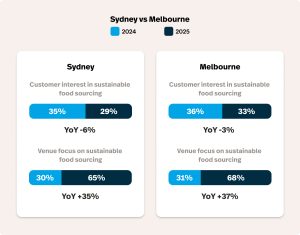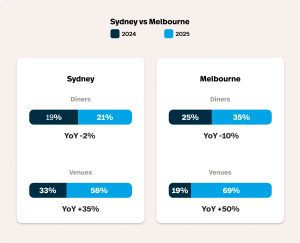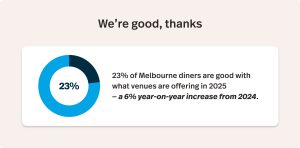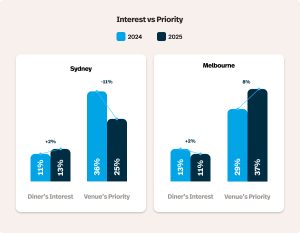
In theory, Australian diners are united by a shared love of good food, good company and good value. But in practice? It depends which city you’re in.
Sydney and Melbourne might be neighbours on the map, but when it comes to hospitality trends, they’re living in different worlds. The latest Lightspeed data reveals a widening divide in how diners across Australia’s two biggest cities are thinking about food in 2025—and what they want from the venues they visit.
Sydneysiders are chasing experiences. Think long brunches, vibrant fusion and menus that change with the seasons. Melburnians, meanwhile, are doubling down on values—championing inclusivity, flexibility and quietly high standards.
And while venues in both cities are working hard to meet expectations, the signals from customers are clear: these cities don’t want the same things. Not even close.
Let’s jump into things.
- Shared priorities, slipping interest
- Melbourne doubles down on inclusivity
- Sydney leans into fun
- An unexpected outlier
- The wellness divide
- The missteps
- Know your crowd, not just the trends
Want the full picture?
See how Australian diners are changing their ways in 2025. Download the Lightspeed Hospitality Report now.
Shared priorities, slipping interest
Let’s start off with a measure of civility and good, old-fashioned unity.
Sydney and Melbourne both list sustainable food sourcing as a top priority for diners in 2025. In Sydney, 29% of customers said they wanted to see local and seasonal ingredients on menus; in Melbourne, that number climbs to 33%.
But here’s the twist—both of these numbers are down year over year.
In Sydney, interest in sustainability fell by 6%, the striking thing here being that this is the single biggest customer drop across all categories for the Harbour City. Melbourne still dipped, but only 3%.
That’s not to say sustainability no longer matters—it clearly still does. But the decline hints at a shifting mindset. Where once sustainability was a hot trend, it may now be considered standard. Expected, but no longer exciting. Something diners assume will be handled well without needing to ask.
The venues haven’t got the memo.
In Sydney, 65% of merchants now say they prioritise sustainable food sourcing—a staggering 35% jump year over year. Melbourne tells a similar story, with 68% of venues focused on sustainability, up 37% since last year.
What’s notable here is not just the scale of investment but how closely it mirrors customer sentiment. In both cities, sustainability ranks among the top customer priorities, even if interest has dipped slightly year over year. That kind of alignment—where what diners care about and what venues deliver actually match—is rare. And it shows that, at least on the big-picture items, Sydney and Melbourne venues are paying attention to the right signals.
The takeaway? Sustainability is still a pillar—but for venues, the challenge now is redirecting that energy toward where customer appetite is actually growing.
Melbourne doubles down on inclusivity
If sustainability is the shared foundation, dietary inclusivity is where Melbourne truly steps into its own.
In 2025, catering to dietary requirements is the top customer priority. A full 35% of diners say it matters most when choosing where to eat, up from 25% last year. That 10% year-over-year surge is the single biggest customer jump across both cities.
And it’s a stat that says a lot without saying much at all. It suggests a city that doesn’t just value these options—it expects them. Whether it’s allergies, lifestyle choices or cultural preferences, Melbourne diners want to see menus that meet them where they are, no substitutions required.
And the venues are listening—possibly too much.
A huge 69% of Melbourne venues now say they prioritise catering to dietary needs, up by 50% year over year. That’s not just alignment—it’s overcorrection. If anything, Melbourne’s venues are racing ahead of their diners in this category, doubling down on inclusivity as a defining feature of the city’s food culture.
Sydney, by contrast, is inching forward. Customer interest in dietary requirements is growing—but only modestly, up 2% to 21% in 2025. The merchant side is more enthusiastic, with 58% now saying it’s a focus, but the overall picture is clear: Sydney’s dining public is only just warming to Melbourne’s levels of inclusivity.
It’s a sharp divide, and one that tells us a lot about how, in Melbourne, the menu isn’t just a list of options—it’s a mirror. And diners expect to see themselves reflected in it.
Sydney leans into fun
While Melbourne is building a dining culture around inclusivity, Sydney is chasing something altogether different and unashamedly Sydney: vibes.
Two of the city’s top three customer wants for 2025 are all about atmosphere and novelty. Fusion food and bottomless drinks both sit at 26% of customer preference—just a whisker behind sustainability—and they represent the most distinct flavour of Sydney’s hospitality scene.
Fusion food, in particular, has cemented itself as a staple. Its popularity held steady year over year, showing no signs of burnout or backlash. In a city that thrives on movement and change, menus that cross cuisines and surprise with each course are clearly still landing.
But it’s bottomless drinks where things get more interesting—and more divisive.
In Sydney, customer interest in bottomless drinks rose by 3% year over year, a respectable bump that confirms its staying power in the desires of the dining public. Whether it’s mimosas at brunch or bottomless margaritas with tacos, the format continues to appeal to diners who see a meal as an event—not just sustenance.
A different story in Melbourne
Customer interest in bottomless offerings plummeted by 8%—the single biggest decline in any category across both cities. And yet, oddly enough, Melbourne venues are still investing in the format, with a 2% increase in prioritisation. It’s a rare moment where venues are trying to sell something customers are clearly walking away from.
In Sydney, the opposite problem exists. Despite rising demand, merchant focus on bottomless drinks has remained completely flat at 31%—a missed opportunity for venues that could be leaning into the trend more strategically.
So while Sydney diners are clearly thirsty, the venues haven’t quite kept pace. And in Melbourne, it seems like the taps are looking to flow more freely for an audience that’s angling to leave the party.
An unexpected outlier
Among Melbourne’s top three customer preferences for 2025—alongside dietary requirements and sustainability—is a somewhat unexpected entry: “nothing in particular.”
That’s right. 23% of Melbourne diners say they’re good with what’s already out there for them when they’re after a place to eat—no notes. That’s up 6% year over year, making it a significant customer shift for the city.
It’s a stat open to interpretation—and one that reveals just as much through its ambiguity.
Melbourne’s dining scene has long been celebrated for its depth, consistency and quality. Perhaps diners aren’t asking for more because they’re already getting what they want.
But it could also hint at fatigue. A kind of trend exhaustion, where the constant churn of new concept hype has numbed expectations.
This creates a sharp contrast with Sydney.
In the Harbour City, the number of diners selecting “nothing in particular” dropped by 2%, bringing it down to just under 20% of respondents. That subtle shift reinforces what we’ve already seen: Sydney diners are becoming more opinionated, more expressive and more interested in shaping their experience.
If Melbourne is saying, “We’re good, thanks,” Sydney is saying, “Here’s what we’d like next.”
The wellness divide
Functional foods—those “better-for-you” options claiming to support gut health, mental clarity or immunity—are an interesting litmus test for where venue priorities are lining up with reality. And in both Sydney and Melbourne, they’re not.
In Sydney, diners are showing growing interest in functional foods, with a 3% year-over-year increase bringing customer demand to 13% in 2025. This isn’t a runaway trend, but this isn’t why we’re highlighting it.
We’re highlighting functional foods because venues are moving the opposite direction at a significant rate.
Functional food prioritisation among Sydney venues dropped 11%, from 36% in 2024 to 25% in 2025. That’s a major retreat just as customers are warming up to the idea. If anything, Sydney’s wellness-minded crowd is being underserved, and venues may be walking away from a category with room to grow.
And in Melbourne, it’s the inverse.
Customer interest in functional foods has declined by 2%, slipping to just 11% for 2025. But venue focus is up, with a modest 8% increase in venue prioritisation—up to 37% for 2025. That 2% might not sound like much—but it’s moving an already misaligned area towards a larger misfire. In short, Melbourne venues are pushing wellness harder than their diners are asking for.
It’s one of the few categories where both cities are out of step. Sydney venues are pulling back too soon. Melbourne venues are hanging on too long.
In both cases though, the result is the same: menus that miss the moment.
The missteps
I know what you’re thinking: what about the big missteps? The biggest discrepancies between what the public wants and what the venues are pushing?
Well, wait no longer.
In Sydney, venues are making a strong push into vegan and plant-based offerings—55% of venues in 2025 prioritise it, up 27% year over year. But their customers don’t share the enthusiasm. Interest in vegan options is falling, down 3% to just 14% in 2025.
That’s a definitional disconnect if ever there was one.
Melbourne’s blind spot? Bottomless drinks.
Despite a sharp 9% drop in customer interest for bottomless drinks in 2025—bringing demand down to 17%—venues have increased their focus on bottomless drinks by 2%—up to 31% for 2025.
It’s the clearest case of over-investment in something diners no longer want—proof that not every crowd-pleaser stays pleasing forever.
Know your crowd, not just the trends
If there’s one thing this data makes clear, it’s that Australia doesn’t dine with one voice. Sydney and Melbourne might be neighbours on the map, but they’re speaking very different culinary languages—and diners in each are setting the tone.
In Melbourne, the story is one of values. Flexibility. Inclusion. A dining scene built around menus that reflect who people are, not just what they feel like eating.
In Sydney, it’s about the vibes—the novelty—formats that feel like events, where food is just one part of the experience.
Neither is right. Neither is wrong. But both are distinct—and if you’re in the business of hospitality, that distinction should matter to you more than ever.
Because while it’s easy to chase national trends or follow what’s hot on the socials, the best-performing venues in 2025 will be the ones that listen to their locals. Who spot the subtle shifts in appetite before the stats confirm them. Who knows when to double down—and when to back off.
The full report breaks this down—and more—but the takeaway is simple: don’t just read the trends. Read the room.

News you care about. Tips you can use.
Everything your business needs to grow, delivered straight to your inbox.


